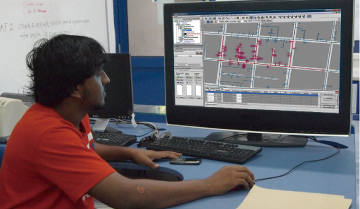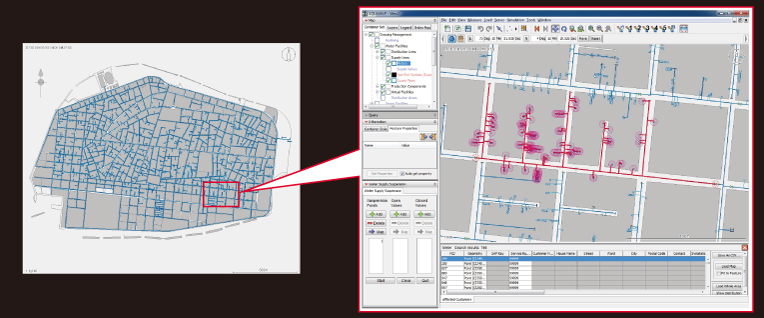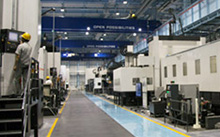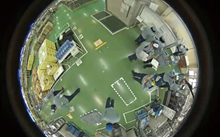As rising urban populations and economic development in the emerging markets of Southeast Asia and elsewhere generate growing demand for water, leaks from water pipes are becoming a major concern. Not only do these leaks waste precious water resources, they impede sound waterworks management. However, identifying the location of a leak in an extremely complicated network of water pipes is not an easy task. To resolve this problem, Hitachi has developed an innovative system that applies simulation analysis technologies.
As global water demand rises, driven by rising populations and economic development in emerging markets, the challenge is not simply to secure the water resources needed to meet this demand, but to use these resources with minimal waste. However, in many regions, a large amount of the water supplied from water treatment plants is lost due to leaks and other factors before it reaches end users in factories and households. In some areas, such non-revenue water accounts for more than 30% of water supply. The higher the rate of non-revenue water and the greater the loss of tap water, the more difficult it becomes to manage the waterworks business. This can have a wide range of negative effects, including rapid increases in the water fees charged to consumers.
Hitachi has been applying ICT to resolve these issues. Specifically, it employs water supply operation information and control systems drawn from its monitoring control systems and its pipe-network management systems. Based on these technologies, it seeks to reduce water losses from leaks and to enable efficient waterworks operations through links to other systems, including systems for water distribution control and leakage management.

Of the various approaches to resolving these issues, Hitachi is effectively combining the core systems described above and has already initiated global deployment of this technology.
For example, it has developed a pipe-network management system in Malé, the capital city of the Maldives. This system uses a database containing data on the water pipe network and volumes of water used by households to simulate water pressure and water service interruptions. This makes it possible to formulate effective plans for renovation and construction work on the water pipe network. Developing a structure like this to systematically renew aging water pipes and equipment ultimately helps prevent water leaks. In addition, the advanced ICT solutions adopted for this waterworks system in the Maldives contribute to business efficiency and the stability of waterworks management.

An example of simulation analysis to identify areas subject to interruptions in water supply
Another example is the water distribution control system adopted by the city of Kashiwa, Chiba Prefecture. Upgraded in 2010, this water distribution control system precisely controls the pressure of the pumps that distribute water to users in factories and households. Reducing instances of excess pump pressure reduces the impact on water pipes, which in turn reduces leaks. At the same time, reducing the power requirements for water distribution pumps has allowed Kashiwa's waterworks bureau to reduce energy costs by some 8%.
Hitachi has developed a unique water leakage management system to address the issue of water loss, an issue emerging as a major topic of concern in urban areas of Southeast Asia and elsewhere. Reducing the volume of water lost through leaks requires rapid identification of leakage locations and rapid implementation of investigations and repairs. However, since these tasks typically rely on human expertise—for example, when audio equipment is used to locate leaks—they are resource-intensive in terms of both time and labor.
In response, to enable more efficient countermeasures against leaks, Hitachi developed a technology for identifying areas where leaks are more likely to occur. Specifically, Hitachi applied simulation analysis that integrated information from water volume and pressure sensors installed on the water pipe network with asset data (e.g., the age of the water pipes and their anticipated wear and tear), along with hydrological analysis, to estimate areas where water is more likely to leak. By focusing attention on limited areas where leaks are more likely to occur before on-site investigation, leakage management methods employing this technology dramatically reduce the time from when a leak is discovered until countermeasures can be implemented. Since a system for estimating likely leakage points requires fewer sensors, this approach also has the advantage of low cost.
To verify the results of this water leakage management system, from August 2013 through September 2014, Hitachi conducted field testing using the water pipe network in Singapore. These tests, which used water released from fire hydrants to model leaks, successfully identified increases in simulated leaks in areas in which water was released and showed the system could be used with a relatively small number of sensors. In fact, a minimum of one sensor per area subject to estimation proved sufficient. In 2016, based on these positive results, Hitachi began providing this system in Southeast Asia and other areas plagued by high rates of non-revenue water.

Hitachi's solutions to address systemic water leaks integrate a broad range of systems and technologies, including water leakage management systems, that draw on the strengths of both operational technology (OT) and information technology (IT). Today, facing rising demand for more effective use of precious water resources, Hitachi is committed to applying its monitoring control and pipe-network management systems to make water supply systems more efficient and to address other water issues worldwide.
Release Date: July 2017
Solutions By: Hitachi, Ltd. Water Business Unit







